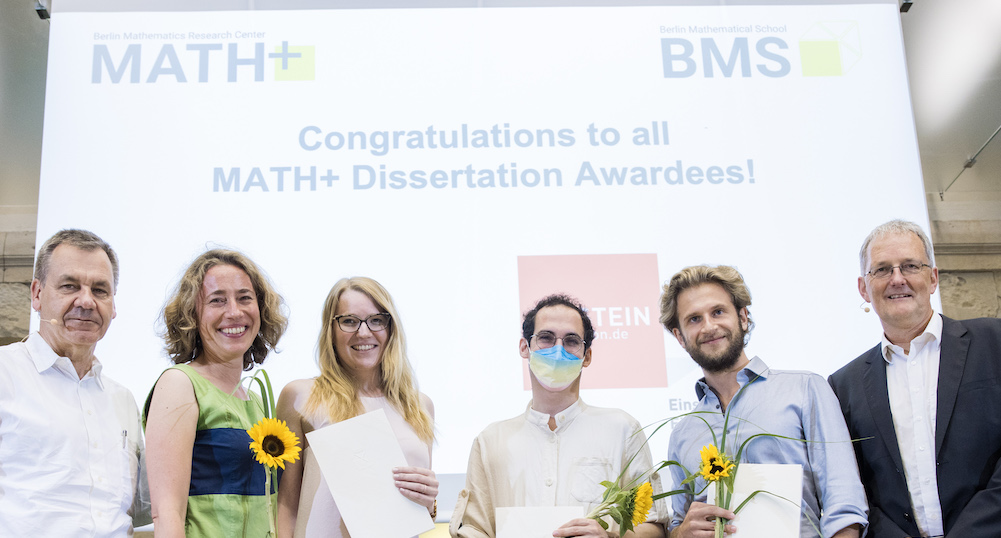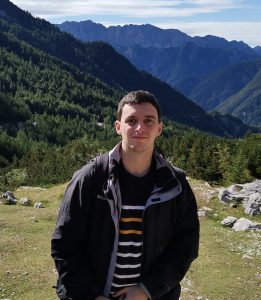MATH+ Dissertation Awards 2021

MATH+ Dissertation Awards 2021, presented on 01 July 2022 at the festive “Celebrating Math” event at the BBAW in Berlin (from left to right):
Jürg Kramer (BMS Chair), Nadja Wisniewski, (MATH+ Managing Director) Lena Walter (Award 2021), Josué Tonelli-Cueto (Award 2020), Paul Hager (Award 2021), Christof Schütte (MATH+ Chair) | Photo: © Kay Herschelmann
In cooperation with the Einstein Foundation Berlin, the Berlin Mathematical School (BMS) of the Cluster of Excellence MATH+ awards up to three annual prizes for outstanding dissertations to BMS graduates. We are delighted to announce that the MATH+ Dissertation Awards 2021 have been presented to Dr. Lena Walter, Dr. Paul Peter Hager, and Dr. Ander Lamaison Vidarte for their excellent theses.
Congratulations from MATH+!
Lena Walter

Solving problems and bringing order to things have always been two of Lena’s favorite occupations. Therefore, it was a natural idea to study math, and so she did. After she graduated from Goethe Universität Frankfurt, visiting a BMS Friday was one of the reasons that convinced her to come to Berlin for her PhD. Thus, in 2015 Lena joined Prof. Christian Haase’s group “Discrete Algebraic Geometry & Math for Teaching Post” at Freie Universität Berlin and the Berlin Mathematical School. When she was not busy doing research, she spent a lot of time teaching, talking, and explaining math – also very high up on the list of her very favorite things to do.After completing her doctorate, Lena began to solve problems at and bring order to the Federal Ministry of Education and Research (BMBF) as a consultant in 2021.
Dissertation: “Toric Newton–Okounkov Functions, the Kingman Coalescent, and Fully Mixed Cells – A Polyhedral View”
When asked what I do all day long, my family has been known to say ‘Drawing parallelograms into trapezoids’, which is not entirely false. However, my thesis has 69 additional figures and, beyond that, a lot of reasoning to offer. Here, Poincaré’s quote “Geometry is the art of reasoning well from badly drawn figures.” applies quite accurately. On the one hand, we are studying objects originating from discrete geometry, and on the other hand, we are looking for polyhedral structures in settings that originate from problems in (toric or numerical) algebraic geometry or mathematical population genetics. Thus, the original problems can be attacked through the use of geometric tools. Once solved, we translate the insights back into the language they were originally phrased in.
Paul Peter Hager

Paul Peter Hager was born and raised in northern Bavaria. After he obtained his university qualification in a secondary education path through the Fachoberschule Bamberg in 2012, he moved to Berlin to study mathematics. From the beginning of his academic career, Paul Hager was always connected to TU Berlin. He received his B.Sc. focusing on probability theory in 2016 and his M.Sc. emphasizing stochastic analysis and mathematical finance from TU Berlin in 2019. In April 2019, he started his PhD research at TU Berlin as a BMS member under the supervision of Prof. Peter K. Friz and Dr. habil. Christian Bayer. During his PhD studies, he worked as a scientific assistant in the MATH+ project AA4-2 „Optimal control in energy markets using rough analysis and deep networks”, and completed his PhD only two and a half years later, in September 2021. He has held a postdoctoral position at the Humboldt Universität zu Berlin since October 2021 in the research group „Applied Financial Mathematics & Applied Stochastic Analysis” led by Prof. Dr. Ulrich Horst.
Dissertation: “Rough Analysis with Application in Markets and Related Fields”
The thesis presents several results on the study and application of stochastic processes with rough sample paths, i.e., temporarily evolving systems with random states. The first main results characterize the distribution of semimartingales – a general class of stochastic processes essential to financial mathematics – by presenting an expansion of its signature cumulants. This touches different fields beyond stochastic analysis, such as algebra and differential geometry. In the second of four parts, a methodology for solving stochastic optimization problems is proposed for situations with intricate dependency on the past. Here the path signature is combined with deep neural networks, also resulting in successful numerical evaluations. The four papers comprising his theses were published in peer-reviewed journals (two in the Annals of Applied Probability and one in the Forum of Mathematics, Sigma).
More information about Paul Peter Hager
Ander Lamaison Vidarte

Ander Lamaison began his Bachelor’s studies at Polytechnic University of Catalonia’s CFIS double degree program, which he came to know through math olympiads. He studied mathematics and aerospace engineering there and graduated in 2015. After attending a workshop at Freie Universität Berlin, he decided to apply to the Berlin Mathematical School. He completed his Master’s and PhD studies at the “Combinatorics and Graph Theory” group at FU Berlin, under the supervision of Prof. Tibor Szabó. Since 2020, Ander has held a postdoc position at Faculty of Informatics of the Masaryk University in Brno, Czech Republic. There, he works in Prof. Dan Král’s group at the “Laboratory of Discrete Methods and Algorithms” (DIMEA). In addition, he regularly helps with the organization of various high school and undergrad mathematical competitions.
Dissertation: “Upper Density Problems in Infinite Ramsey Theory“
Ramsey theory is the study of partitioned (or “colored”) discrete structures. When the elements of a structure (such as edges of a graph) are colored using a given number of colors, Ramsey theory studies the kinds of single-colored substructures (such as subgraphs) that one is guaranteed to find. Traditionally, infinite Ramsey theory has been studied mostly on a qualitative level, in contrast to the quantitative treatment that finite Ramsey theory has received. A problem of Erdős and Galvin, which is solved in this thesis, asks about the density of single-colored paths in a certain colored infinite graph. This problem acts as a bridge between finite and infinite Ramsey theory, bringing quantitative tools into an infinite setting.
More information about Ander Lamaison Vidarte

